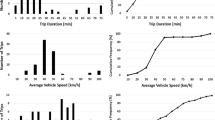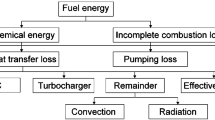Abstract
Comprehensive performance experiments were carried out, and the thermodynamic temperature simulation model was established based on the independently researched and developed environmental chamber (EC) that integrates temperature, relative humidity, and pressure for the environmental worthiness test of fuel cell vehicle (FCV) engines. The results show that the control ranges of temperature, relative humidity, and absolute pressure in the EC are − 40–70 °C, 10–95%, and 100–50 kPa; the deviations are ± 1 °C, ± 2%, and ± 1 kPa; and the uniformities are 0.5 °C, 2.46%, and 0.63 kPa, respectively. Higher requirements for equipment and controlling system are needed to achieve such range, accuracy, and uniformity in a space as large as 95 m3. The simulation model accurately and effectively reflects the temperature variation in the EC. Therefore, the proposed model will be used as guidance for the FCV engine temperature test.








Similar content being viewed by others
Abbreviations
- \(C\) :
-
specific heat of the species (J mol-1 K-1)
- \(M\) :
-
relative molecular mass (kg mol-1)
- \(T\) :
-
temperature (K)
- \(t\) :
-
time (s)
- \(Q\) :
-
heat flux (J s-1)
- \(H\) :
-
enthalpy (J)
- \({\text{tcc}}\) :
-
thermal contact conductance (W m-2 K-1)
- \(A\) :
-
conduct surface (m2)
- \({\text{sf}}\) :
-
shape factor (m)
- \({\text{ctr}}\) :
-
contact thermal resistance (K W-1)
- \(l\) :
-
characteristic length (m)
- \(L\) :
-
length (m)
- \(W\) :
-
width (m)
- \(Cp\) :
-
specific heat (J kg-1 K-1)
- \(Pr\) :
-
Prandtl number
- \(Gr\) :
-
Grashof number
- \(Ra\) :
-
Rayleigh number
- \(Re\) :
-
Reynolds number
- \(Nu\) :
-
Nusselt number
- \(h\) :
-
convective exchange coefficient (W m-2 K-1)
- \(ReTrans1\) :
-
laminar-to-turbulent transition for forced convection: lower Reynolds number
- \(ReTrans2\) :
-
laminar-to-turbulent transition for forced convection: upper Reynolds number
- \(\varPhi\) :
-
heat flux(W)
- \(\lambda\) :
-
thermal conductivity (W m-1 K-1)
- \(\delta\) :
-
distance between the two temperature points (m)
- \(\mu\) :
-
absolute viscosity (kg m-1 s-1)
- \({\text{g}}\) :
-
gravity acceleration (m s-2)
- \(\rho\) :
-
density (kg m-3)
- \(\alpha\) :
-
volumetric expansion coefficient (1 K-1)
- \(\nu\) :
-
velocity (m s-1)
- \(k\) :
-
gain on heat exchange
- \(\theta\) :
-
angle (°)
- \(gen\) :
-
generated
- dis:
-
dissipation
- ele:
-
electricity
- wal:
-
wall
- doo:
-
door
- win:
-
window
- ben:
-
bench
- gro:
-
ground
- Por1:
-
port1
- Por2:
-
port2
- Fil:
-
film
- Flu:
-
fluid
- fre:
-
free
- for:
-
forced
References
Kwan TH, Wu XF, Yao QH. Multi-objective genetic optimization of the thermoelectric system for thermal management of proton exchange membrane fuel cells. Appl Energ. 2018;217:314–27.
Afshari E. Computational analysis of heat transfer in a PEM fuel cell with metal foam as a flow field. J Therm Anal Calorim. 2020;139(4):2423–34.
Robledo CB, Oldenbroek V, Abbruzzese F, van Wijk AJM. Integrating a hydrogen fuel cell electric vehicle with vehicle-to-grid technology, photovoltaic power and a residential building. Appl Energy. 2018;215:615–29.
Nagula M. Forecasting of fuel cell technology in hybrid and electric vehicles using Gompertz growth curve. J Stat Manag Syst. 2016;19(1):73–88.
Hames Y, Kaya K, Baltacioglu E, Turksoy A. Analysis of the control strategies for fuel saving in the hydrogen fuel cell vehicles. Int J Hydrog Energy. 2018;43(23):10810–21.
Das HS, Tan CW, Yatim AHM, Li SH. Fuel cell and ultracapacitor energy system control using linear quadratic regulator proportional integral controller. Electr Eng. 2019;101(2):559–73.
Jamalabadi MYA. Carbon monoxide reduction in solid oxide fuel cell-mini gas turbine hybrid power system. J Therm Anal Calorim. 2019;135(3):1871–80.
Ahmed NA, Madouh JY. High-frequency full-bridge isolated DC–DC converter for fuel cell power generation systems. Electr Eng. 2018;100(1):239–51.
Genç G, Sarikoç S. Energy and exergy analysis of a solid-oxide fuel cell power generation system for an aerial vehicle (ISSA- 2015-139). Int J Green Energy. 2018;15(3):151–60.
Krummrich S, Llabrés J. Methanol reformer—the next milestone for fuel cell powered submarines. Int J Hydrog Energy. 2015;40(15):5482–6.
Xie JM, Hao WQ, Wang FH. The analysis of interfacial thermal stresses of solid oxide fuel cell applied for submarine power. Int J Energy Res. 2018;42(5):2010–20.
Zhang GS, Kandlikar SG. A critical review of cooling techniques in proton exchange membrane fuel cell stacks. Int J Hydrog Energy. 2012;37(3):2412–29.
Li DZ, Li C, Gao ZQ, Jin QB. On active disturbance rejection in temperature regulation of the proton exchange membrane fuel cells. J Power Sources. 2015;283:452–63.
Oono Y, Fukuda T, Sounai A, Hori M. Influence of operating temperature on cell performance and endurance of high temperature proton exchange membrane fuel cells. J Power Sources. 2010;195(4):1007–14.
Wang MH, Guo H, Ma CF. Temperature distribution on the MEA surface of a PEMFC with serpentine channel flow bed. J Power Sources. 2006;157(1):181–7.
Zhao XQ, Li YK, Liu ZX, Li Q, Chen WR. Thermal management system modeling of a water-cooled proton exchange membrane fuel cell. Int J Hydrog Energy. 2015;40(7):3048–56.
Tiss F, Chouikh R, Guizani A. Dynamic modeling of a PEM fuel cell with temperature effects. Int J Hydrog Energy. 2013;38(20):8532–41.
Hosseinzadeh E, Rokni M, Rabbani A, Mortensen HH. Thermal and water management of low temperature proton exchange membrane fuel cell in fork-lift truck power system. Appl Energy. 2013;104:434–44.
Karthik M, Vijayachitra S. An integrated exploration of thermal and water management dynamics on the performance of a stand-alone 5-kW Ballard fuel-cell system for its scale-up design. Proc Inst Mech Eng J Power. 2014;228(7):836–52.
Wu Y, Chen S. Study on water management of proton exchange membrane fuel cell. Beijing: Science Press; 2011.
Blanco M, Wilkinson DP. Investigation of the effect of microporous layers on water management in a proton exchange membrane fuel cell using novel diagnostic methods. Int J Hydrog Energy. 2014;39(29):16390–404.
Boulon L, Agbossou K, Hissel D, Hernandez A, Bouscayrol A, Sicard P et al. (2010) Energy management of a fuel cell system: influence of the air supply control on the water issues. In: IEEE international symposium on industrial electronics (ISIE 2010). 2010:161–6
Chippar P, Kang K, Lim YD, Kim WG, Ju H. Effects of inlet relative humidity (RH) on the performance of a high temperature-proton exchange membrane fuel cell (HT-PEMFC). Int J Hydrog Energy. 2014;39(6):2767–75.
Ko D, Doh S, Park HS, Kim MH. Investigation of the effect of operating pressure on the performance of proton exchange membrane fuel cell: in the aspect of water distribution. Renew Energy. 2018;115:896–907.
Naso V, Lucentini M, Aresti M (2013) Evaluation of the overall efficiency of a low pressure proton exchange membrane fuel cell power unit. In: Proceedings of the IEEE energy conversion congress and exposition, Denver, 2013
Youcef K, Yasmina KZ, Ahmed B. Effect of pressure in proton exchange membrane fuel cell (PEMFC). Int J Energy Eng. 2013;3(3):158–64.
Yu XC, Zhou B, Sobiesiak A. Water and thermal management for Ballard PEM fuel cell stack. J Power Sources. 2005;147(1–2):184–95.
Acknowledgements
This study benefits from the financial support of the Program of Development of Major Scientific Instruments and Equipment of the State (Grant No. 2012YQ150256).
Author information
Authors and Affiliations
Corresponding author
Additional information
Publisher's Note
Springer Nature remains neutral with regard to jurisdictional claims in published maps and institutional affiliations.
Rights and permissions
About this article
Cite this article
Chang, G., Li, Y., Cui, X. et al. Experiment and simulation of environmental chamber performance for fuel cell vehicle engine system. J Therm Anal Calorim 145, 2477–2485 (2021). https://doi.org/10.1007/s10973-020-09805-6
Received:
Accepted:
Published:
Issue Date:
DOI: https://doi.org/10.1007/s10973-020-09805-6




